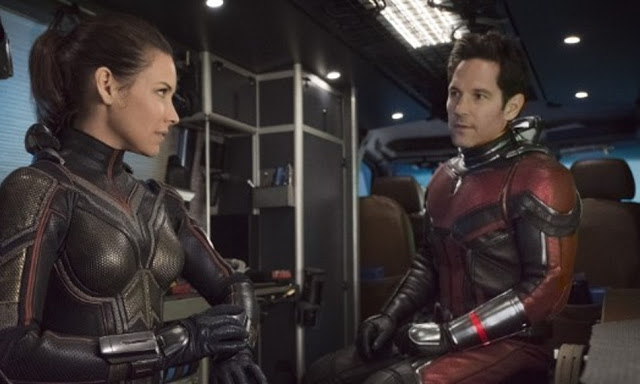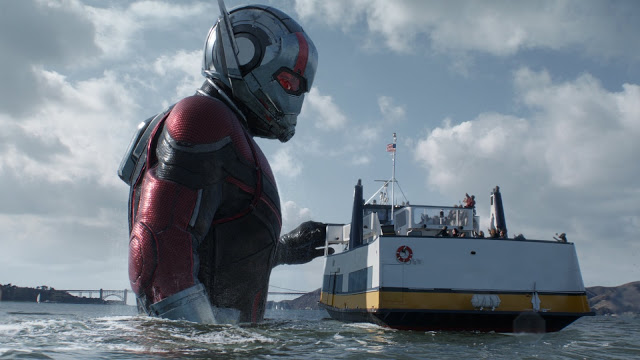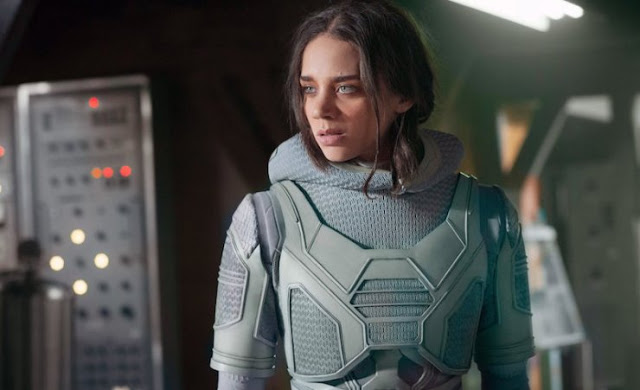When we last left the Marvel Cinematic Universe (all of two months ago!), its foundations had been shaken to their cosmic core. The ending of Avengers: Infinity War carried with it cataclysmic consequences for virtually every member of the MCU, though noticeably absent (or maybe not that noticeably) was Scott Lang, the affable thief better known in comic-book lore as Ant-Man. Perhaps he was busy promoting his own movie. Regardless, in light of Infinity War’s devastating conclusion, it was fair to wonder if Ant-Man and the Wasp—the sequel to the passably entertaining, entirely unmemorable Ant-Man—would feel trivial by comparison. In one sense, it does; after all, no galaxies are threatened in this film, whose kill count is in the single digits rather than the billions. But in another, more important sense, Ant-Man and the Wasp is a significant achievement, because it features a key quality that Infinity War largely lacked. Quite simply: It’s fun.
I don’t want to frame Ant-Man and the Wasp as the antithesis of Infinity War, because it’s still a Marvel movie, with all of the pleasures and obligations that entails. (You’ll never believe this, but Stan Lee has a cameo.) But the differences between the two are nevertheless noteworthy. Where the third official Avengers crossover was absolutely massive—a sprawling undertaking that spanned multiple planets and comprised several dozen heroes and villains—this bug-centric sequel feels insular, with a narrow focus that spares only a handful of glances toward the broader MCU. (Most notable of these is the mid-credits stinger, which elicited gasps at my screening.) And where the tone of Infinity War was grave to the point of lugubriousness, Ant-Man and the Wasp is breezy and jovial. Nobody here is worried about saving the world; they just want to spend time with their families.
Some may dismiss such smallness of scope as inessential or lacking in stakes, and in pure quantitative terms, this movie is undeniably modest. But as someone who’s endured far too many portentous comic-book pictures in which tormented heroes do battle against snarling villains intent on enslaving or massacring the human race, I perceive Ant-Man and the Wasp as a tonic, a playfully gee-whiz production unburdened by extraneous world-building or laborious mythology.
Not that it makes a ton of sense. As in the first film, the script here (credited to five different writers) traffics heavily in pseudo-science mumbo-jumbo, with characters frequently gargling words like “sub-atomic” and “quantum entanglement”. In narrative terms, Scott’s presence is almost incidental; instead, the engine of the plot is Hank Pym (Michael Douglas), who long ago lost his wife (Michelle Pfeiffer) when she, er, vanished into the quantum realm while shrinking herself to defuse a nuclear missile. (Or something.) After discovering at the end of Ant-Man that Scott could safely travel into and out of this microscopic world, Hank and his daughter, Hope van Dyne (Evangeline Lilly), are endeavoring to build a mammoth contraption that will allow them to rescue Janet from thirty years of interdimensional purgatory. Dubious gobbledygook and occasional exposition aside, the premise—a husband longing to reunite with his wife, a daughter imagining life with the mother she barely knew—is actually quite intimate and sweet, and the movie gently taps into an emotional vein without feeling overly manipulative.
It is also aware of its own ridiculousness—“Do you guys just put ‘quantum’ in front of everything?” a bemused Scott asks—which means it never takes itself too seriously. How can it, when its hero is again played by Paul Rudd, one of mainstream cinema’s most amiable stars? The actor hardly stretches himself here, but his comfort with the material is in keeping with the movie’s relaxed vibe; in general, the characters in Ant-Man and the Wasp are just kind of pleasant to be around. Scott’s faux-simmering chemistry with Hope isn’t exactly charged—the two pretties share a sexless kiss that is unfortunately evocative of the non-romance between Chris Pratt and Bryce Dallas Howard in the Jurassic World films—but they exhibit an enjoyably jokey banter, one that’s more rooted in exasperated eye-rolls than smoldering gazes. And the supporting cast is aces. Randall Park charms as a hapless FBI agent tasked with keeping Scott under house arrest (the consequence of his illicit shenanigans in Captain America: Civil War), while Scott’s coworkers—a trio of ex-cons now going legit as security consultants, led by Michael Peña—are a steady source of off-kilter humor; as in the first film, Peña at one point delivers a rambling, hilarious monologue that brilliantly undercuts the putative tension of an interrogation.
Even the villains, typically a source of banal wickedness in the MCU, are misguided or self-serving rather than purely evil. They include an arms dealer named Sonny Burch (Walton Goggins, far better served here than he was in the Tomb Raider reboot), a profiteer who schemes to leverage Hank and Hope’s technology not to subjugate the world, but to line his pockets. And then there is Ghost (Hannah John-Kamen), a mysterious masked and hooded figure who seems to be capable of becoming incorporeal at will. Aided by an old rival of Hank’s, Bill Foster (Laurence Fishburne), Ghost initially appears to be cruel and vicious—can you really trust someone who can walk through walls?—but it turns out she needs Hank’s incredible shrinking tech to stabilize her own biology before she winks out of existence. You almost feel for her.
Tonally and structurally, Ant-Man and the Wasp largely mirrors its predecessor, proceeding as a light-hearted caper with a number of complex, chaotic action sequences. But where this sequel dramatically improves on the original is in the caliber of that action. Some of this is just a matter of judicious pruning; the first Ant-Man was unduly obsessed with articulating the mechanics of Scott’s powers, devoting far too much time to the imbecilic notion that he could communicate with intelligent insects. He still coordinates with bugs this time around, but the director, Peyton Reed, wisely declines to belabor the process, thereby allowing us to better ignore the film’s inherent ludicrousness.
And that pays off, because when it comes to dynamic set pieces, Ant-Man and the Wasp is unusually exciting. Perhaps Reed, unshackled from the need to focus on the ants themselves, could better direct his attention to his human characters, or maybe he was just more confident sitting in the director’s chair from the start. (He assumed duties midway through the first installment after Edgar Wright left the project.) Either way, the action here is smart, lively, and coherent, with Reed capitalizing on his heroes’ unique capabilities. The fight scenes, which the MCU often conducts as groaning, sound-effects-laden punch-fests, are spry and unpredictable, relying on stealth as much as strength. And not only can Scott and Hope, aka the Wasp, reduce themselves to virtually invisible size—the Wasp also sports a nifty pair of wings—but they invariably shrink inanimate objects as well. This allows Reed to toy with size and scale, which he does to increasingly humorous effect; giant laboratories collapse into handy suitcases, while lumbering vehicles can disappear on command. Such flexibility could have played like cheating, but Reed develops a consistent grammar that allows him to deliver thrills—including a franchise-best car chase—as well as laughs.
At one point, Scott and Bill trade war stories about how they once they used Hank’s technology not to become smaller, but to grow to colossal size. It’s essentially the comic-book version of dick-measuring—Hope makes an acid remark along those lines—but it’s also something of a feint. Ant-Man and the Wasp doesn’t want to be the biggest; it just wants to show us a good time. In that humble, strangely noble goal, it succeeds. In so doing, it reminds us that sometimes, the smallest superhero movies can carry the sharpest sting.
Jeremy Beck is the editor-in-chief of MovieManifesto. He watches more movies and television than he probably should.




